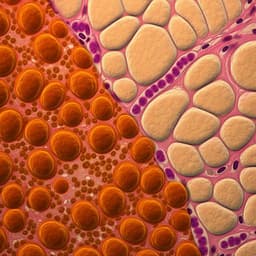
Food Science and Technology
Short-term *Cudrania tricuspidata* fruit vinegar administration attenuates obesity in high-fat diet-fed mice by improving fat accumulation and metabolic parameters
J. Choi, M. Kim, et al.
This fascinating study by Jun-Hui Choi, Myung-Kon Kim, Soo-Hwan Yeo, and Seung Kim explores the anti-obesity effects of vinegar fermented with Cudrania tricuspidata fruits. Discover how this functional food may help reduce body fat accumulation and improve metabolic health in high-fat diet-fed mice.
~3 min • Beginner • English
Introduction
Obesity prevalence is rising globally and is associated with caloric surplus and environmental factors, increasing risks of metabolic and cardiovascular diseases. Pharmacotherapies can be effective but often have adverse effects. Vinegar, traditionally used as a food and medicinal ingredient, has been associated with reductions in body weight, lipids, and hyperglycemia. Fruit vinegars enriched with bioactives may enhance these benefits. Cudrania tricuspidata (CT), an East Asian medicinal/food plant rich in flavonoids and phenolics, has reported anti-obesity effects, but the mechanisms and efficacy of C. tricuspidata fruit vinegar (CTFV) remain unclear. This study evaluates the anti-obesity efficacy of CTFV versus pomegranate fruit vinegar (PFV; a KFDA-approved functional ingredient) and fenofibrate in a high-fat diet (HFD)-induced obese mouse model, characterizing bioactive constituents, metabolic enzyme modulation, and molecular signaling changes.
Literature Review
Prior work has shown vinegar intake can lower cholesterol and atherosclerosis in animals, reduce body weight and lipid levels in obese mice, and improve postprandial glycemia in humans. Vinegars exhibit antimicrobial, antitumor, antioxidant, anti-fibrotic, and anti-kidney stone activities and, when produced from fruits, are enriched in polyphenolics (e.g., chlorogenic acid, ferulic acid, syringic acid) implicated in anti-obesity and metabolic regulation, often via AMPK activation and suppression of SREBP-1c/PPARγ. C. tricuspidata fruits contain flavonoids and phenolics with reported anti-obesity and antioxidant effects. However, CTFV’s in vitro/in vivo efficacy and mechanisms had not been comprehensively evaluated, warranting the current investigation.
Methodology
CTFV production: Fresh C. tricuspidata fruits were homogenized (1:2 with water), adjusted to 24°Brix, sterilized (85°C, 90 min), and fermented with Saccharomyces cerevisiae (10 days, 26°C). Wine was mixed 1:1 with a traditional starter vinegar and incubated 60 days at 30°C with periodic feeding and acidity monitoring to produce vinegar. Physicochemical properties (pH, °Brix, total acidity, alcohol) were measured during fermentation.
HPLC analysis: A Waters HPLC-DAD system with ZORBAX Eclipse XDB-C18 column quantified phenolic acids/flavonoids (detection at 280 nm) and parishin derivatives (220 nm) using formic acid-acetonitrile or formic acid-methanol gradients. Identification was by retention time versus standards; quantification by peak area against calibration curves for 20 standards.
In vitro enzyme assays: Inhibition of pancreatic lipase, lipoprotein lipase, β-glucosidase, α-amylase, phosphodiesterase IV (PDE IV), citrate synthase (CS), and alkaline phosphatase (ALP) was assessed using specific chromogenic substrates (e.g., p-nitrophenyl butyrate, p-NPP, p-nitrophenyl-β-D-glucopyranoside, starch) with absorbance at 405, 412, or 580 nm. Inhibition (%) calculated by standard formulas. Triplicates performed.
Cell culture/viability: 3T3-L1, HepG2, and Raw264.7 cells were cultured in DMEM with 10% FBS. Cytotoxicity of CTFV (30–1000 µg/mL) was assessed by MTT after 24–48 h.
Animals and diet-induced obesity model: Fifteen-week-old male ICR mice were fed either control chow (LabDiet 5L79) or HFD (60% fat; TestDiet 58Y1) for 50 days. Groups (n=10) received vehicle, fenofibrate (200 mg/kg/day), PFV (500 mg/kg/day), or CTFV (500 mg/kg/day) orally for 50 days. Body weight and food intake were recorded every 5 days; feed efficiency ratio calculated. At study end, after 12 h fasting, mice were euthanized; blood and tissues (liver, kidney, spleen, adipose depots) were collected for analyses. Liver homogenates were prepared for enzymatic/oxidative assays.
Histology: Liver and white adipose tissues were fixed and stained (H&E; Oil Red O for hepatic lipid). Adipocyte size and hepatic fat density were quantified using ImageJ.
Oxidative stress assays: Serum and liver catalase (CAT), superoxide dismutase (SOD), glutathione peroxidase (GPx) activities; lipid peroxidation (MDA via TBARS); nitric oxide metabolites (NOx) were measured spectrophotometrically by standard methods.
In vivo enzymatic activities: Activities of pancreatic lipase, lipoprotein lipase, β-glucosidase, α-amylase, PDE IV, CS, and ALP were assayed in serum and liver homogenates with specific substrates; activities expressed as U or mU per mg protein.
Biochemistry: Serum TC, HDL, TG, AST, ALT, glucose, TP, albumin determined by automated chemistry analyzer; LDL and VLDL calculated (Friedewald). HTR (HDL/TC) computed. Insulin, leptin, adiponectin measured by ELISA; HOMA-IR calculated. Atherogenic indices (AI, AC, CRR, CAI) computed per standard equations.
Immunoblotting: Liver protein extracts were resolved by SDS-PAGE and probed for adipoR1, leptin receptor (OBR/pOBR), IRS1/pIRS1, PI3K/pPI3K, AKT/pAKT, ERK/pERK, JNK/pJNK, p38/pp38, AMPK/pAMPK, ACC/pACC, GLUT4, SREBP1c, PPARα, PPARγ, C/EBPα, C/EBPβ, FAS, PTP1B, with β-actin loading control. Densitometry performed.
Statistics: Data are mean ± SD. One-way ANOVA with Tukey post hoc; p<0.05 considered significant. Ethical approval obtained; animal care followed NIH guidelines.
Diet compositions and fermentation physicochemistry were documented (Tables 1–2).
Key Findings
- CTFV composition and bioactives: HPLC identified major constituents including chlorogenic acid (~331.9 µg/mL), rutin (~142.9 µg/mL), caffeic acid (~46.2 µg/mL), gastrodin (~274.3 µg/mL), p-hydroxybenzoic acid (~120.2 µg/mL), and parishin A (~10.7 µg/mL). Across fermentation, total phenols and flavonoids increased in vinegar (e.g., chlorogenic acid 1423.9±25.3 µg/g dw; rutin 613.0±18.0 µg/g dw).
- In vitro enzyme inhibition: CTFV dose-dependently inhibited α-amylase, pancreatic lipase, lipoprotein lipase, β-glucosidase, ALP, and citrate synthase; no significant effect on PDE IV. Individual compounds (chlorogenic acid, p-hydroxybenzoic acid, parishin A) strongly inhibited pancreatic lipase, β-glucosidase, and citrate synthase.
- Cytotoxicity: No significant cytotoxicity up to 300 µg/mL in 3T3-L1, HepG2, Raw264.7; viability decreased at 500–1000 µg/mL.
- Body weight and feed efficiency: HFD increased body weight gain versus control. CTFV significantly reduced body weight gain compared to DIO and more than fenofibrate; feed efficiency ratio decreased from 0.099±0.006 (DIO) to 0.045±0.003 (CTFV), with no change in food intake.
- Organ and fat masses: HFD increased liver mass and adipose depots. CTFV reduced liver mass (to 1.91±0.22 g vs DIO 3.40±0.86) and epididymal, perirenal, and mesenteric fat masses compared with DIO.
- Hepatic steatosis and adipocyte size: HFD elevated hepatic fat density to 133.8±3.6% of control and adipocyte size to 2.90×10^3 µm². CTFV reduced hepatic fat to 104.2±7.8% and adipocyte size to 1.98×10^3 µm²; PFV and fenofibrate showed lesser improvements.
- Oxidative stress: In serum, HFD increased MDA (3.28±0.13 nM/mL); CTFV lowered MDA to 1.92±0.13. Trends toward improved CAT/SOD with CTFV. In liver, HFD reduced CAT/SOD/GPx and increased MDA/NO; CTFV increased SOD (0.54±0.03 vs DIO 0.46±0.02 U/mg) and reduced MDA (1.43±0.06 vs DIO 1.66±0.04 nM/mL).
- Liver lipids: Liver TG increased with HFD (0.89±0.07 mg/dL); CTFV reduced liver TG to 0.27±0.07, lower than control and other treatments.
- Serum lipids and metabolic markers: Versus DIO, CTFV reduced TC (128.3±3.6 vs 155.0±6.3 mg/dL), TG (89.7±12.1 vs 302.0±14.6 mg/dL), LDL (18.3±3.4 vs 99.7±7.5 mg/dL), VLDL (17.9±2.4 vs 60.4±8.1 mg/dL), and improved HTR. Insulin fell to 0.042±0.013 ng/mL (vs 0.191±0.064) and HOMA-IR to 0.35±0.06 (vs 2.09±0.95). AST/ALT decreased (AST 113.3±6.6 vs 168.5±9.3 U/L; ALT 30.3±2.9 vs 39.9±3.2 U/L). Atherogenic indices improved markedly: AI 0.71±0.03 (vs 2.55±0.19), AC 0.01±0.005 (vs 0.35±0.02), CRR 1.01±0.07 (vs 1.35±0.04), CAI 0.15±0.10 (vs 0.85±0.05).
- In vivo enzyme activities: Serum pancreatic lipase decreased with CTFV (20.77±2.11 vs DIO 26.18±1.97 mU/mg). Hepatic α-amylase, lipoprotein lipase, and β-glucosidase activities were reduced versus DIO; ALP, PDE IV, and CS showed no significant hepatic changes with CTFV.
- Molecular signaling (liver): HFD decreased AdipoR1 and OBR, increased PTP1B and pIRS1, and activated pPI3K/pAKT and MAPKs (ERK, JNK, p38), while suppressing AMPK/pAMPK and ACC/pACC. CTFV upregulated AdipoR1, OBR, IRS1, and OBR phosphorylation; downregulated PTP1B and pIRS1; reduced phosphorylation of PI3K/AKT and MAPKs; and activated AMPK and pAMPK (ACC changes not significant).
- Lipid/glucose metabolism proteins: CTFV increased GLUT4 and PPARα and decreased SREBP1c, C/EBPα/β, and FAS expression versus DIO, consistent with reduced lipogenesis and improved fatty acid oxidation/glucose transport. PFV and fenofibrate showed overlapping but generally lesser effects depending on target.
Discussion
CTFV, rich in phenolic and parishin derivatives (e.g., chlorogenic acid, rutin, caffeic acid, gastrodin, p-hydroxybenzoic acid), exerted anti-obesity effects in HFD-fed mice through multiple complementary mechanisms. In vitro, CTFV and its constituents inhibited digestive and metabolic enzymes (lipases, α-amylase, β-glucosidase, citrate synthase, ALP), indicating potential reductions in fat and carbohydrate absorption and substrate availability for lipogenesis. In vivo, CTFV improved dyslipidemia, insulin resistance (lower insulin and HOMA-IR), hepatic steatosis, adiposity, and oxidative stress markers. Mechanistically, CTFV modulated key hepatic signaling nodes: restored adiponectin and leptin receptor signaling (AdipoR1, OBR), suppressed negative regulation by PTP1B and aberrant pIRS1 activation, attenuated PI3K/AKT and MAPK (ERK/JNK/p38) pathways associated with adipogenesis and lipogenesis, and activated AMPK signaling, promoting fatty acid oxidation and glucose uptake. Downregulation of SREBP1c, C/EBPα/β, and FAS with upregulation of PPARα and GLUT4 supports decreased lipogenesis and enhanced metabolic flexibility. Collectively, these changes explain the observed reductions in hepatic and systemic lipid burden, adipocyte hypertrophy, and cardiovascular risk indices. CTFV frequently matched or exceeded PFV and fenofibrate in several outcomes (e.g., liver TG, AI, adiposity), suggesting synergism between acetic acid and CT-derived polyphenolics.
Conclusion
CTFV significantly attenuated HFD-induced obesity phenotypes in mice, reducing body weight gain, feed efficiency, adipose tissue mass, hepatic steatosis, serum and hepatic lipids, insulin resistance, and oxidative stress. These effects were mediated by inhibition of obesity-related enzymatic activities and by modulation of hepatic signaling pathways (enhanced AdipoR1/OBR/AMPK, reduced PI3K/AKT/MAPKs, decreased SREBP1c/CEBP/FAS, increased PPARα/GLUT4). CTFV outperformed PFV and fenofibrate on several endpoints, highlighting its potential as a functional food or nutraceutical for obesity management. Future studies should include dose–response assessments, long-term safety, gut microbiota interactions, identification of bioavailable metabolites, and randomized clinical trials to confirm translatability to humans.
Limitations
- Preclinical study in male ICR mice; findings may not generalize to females or other species, and human efficacy is unknown.
- Single CTFV dose and 50-day intervention; no dose–response or long-term safety evaluation.
- Primary mechanistic analyses focused on liver; effects in adipose tissue, intestine, and skeletal muscle signaling were not comprehensively profiled.
- Bioavailability and pharmacokinetics of individual CTFV phenolics were not directly measured; in vitro enzyme inhibition may not fully reflect in vivo exposure.
- PDE IV activity showed no change, suggesting limited scope for some metabolic targets.
Related Publications
Explore these studies to deepen your understanding of the subject.







